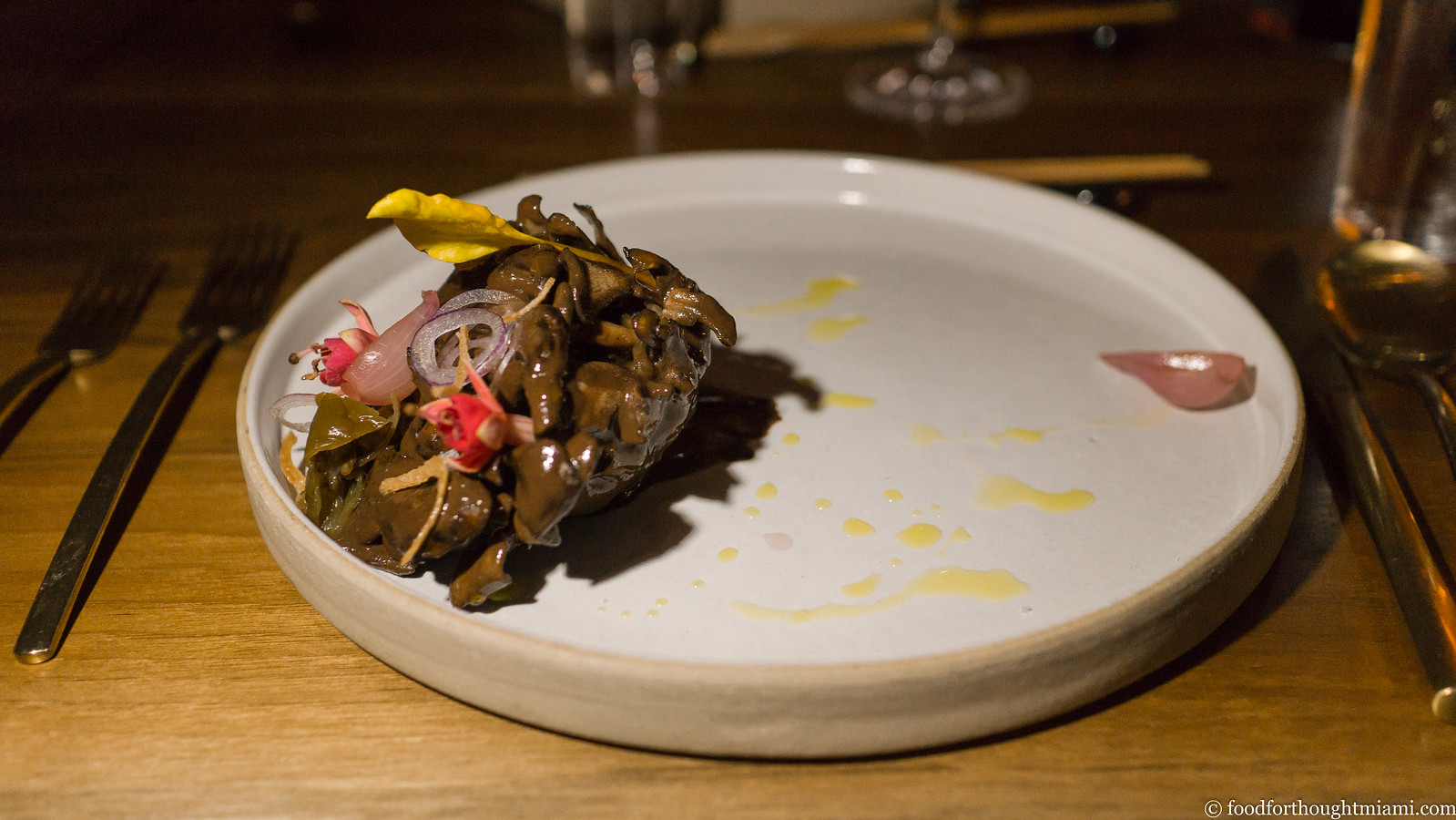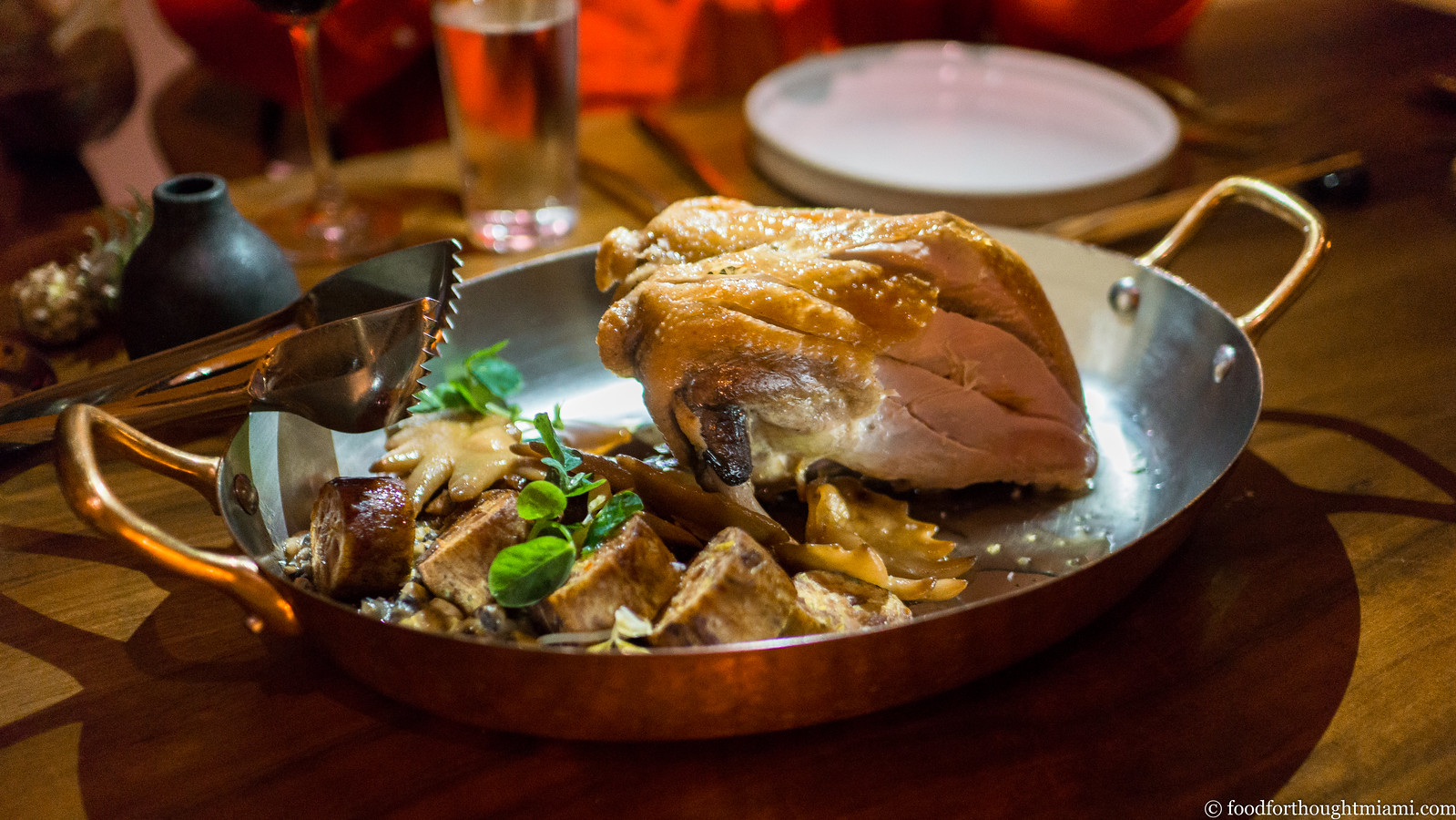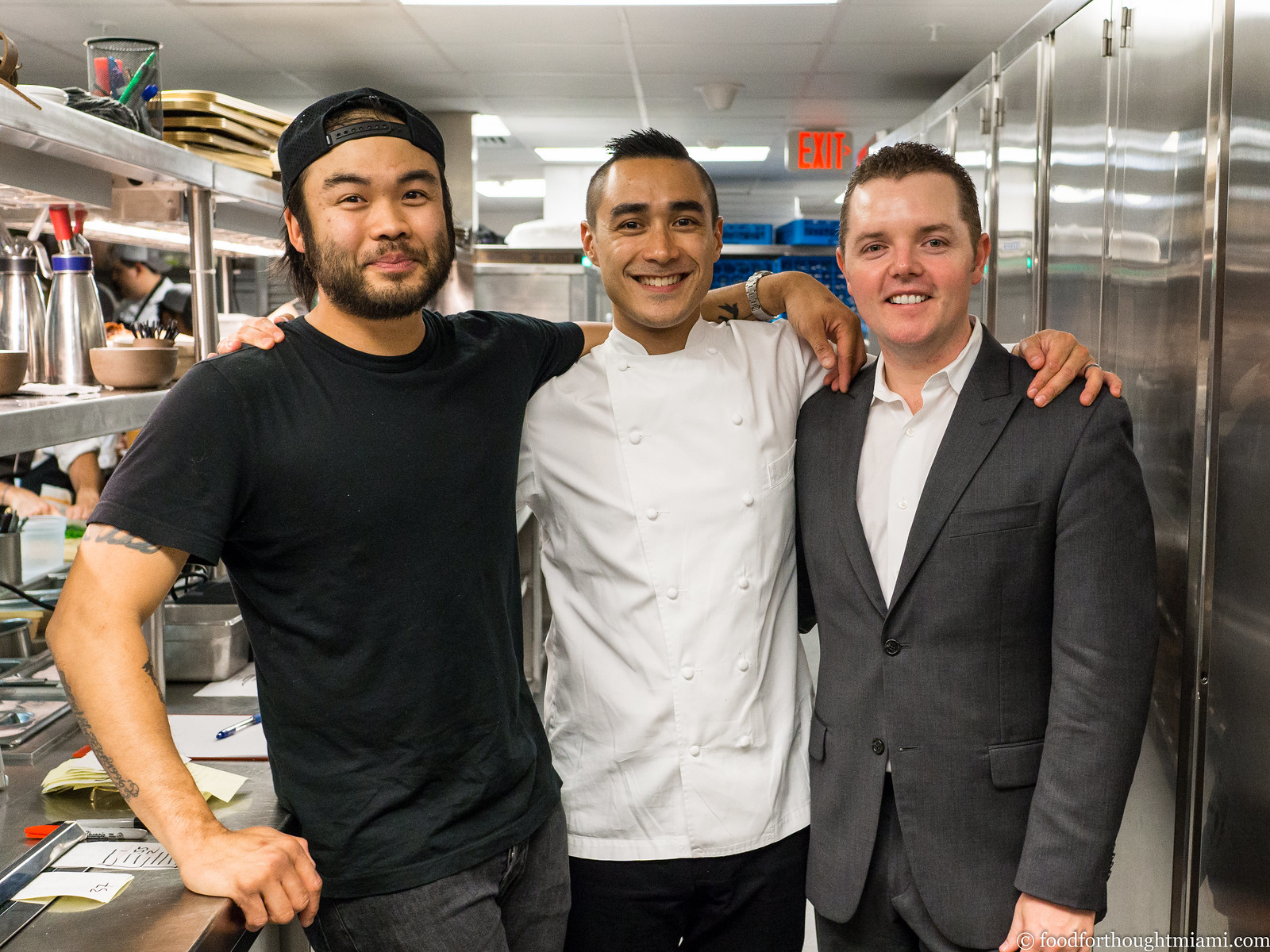Then every so often we miss in the opposite direction, and fail to instill the trust or confidence that emboldens a chef to go outside of their comfort zone.[1] Even a very good meal can be something of a disappointment – for us, anyway – if it doesn't offer something different from the usual restaurant experience.
I'd been to Paul Qui's restaurant Pao in the Faena Miami Beach once before, very shortly after it opened (and wrote about it here, where you can also get much of Chef Qui's back story). I had a good meal – some dishes were great – but it felt restrained, like there was a lot more reverberating under the surface. It almost seemed as if he was cooking for this room, trying to match the polish of the gilded (literally!) ceiling and multi-million dollar Damien Hirst sculpture that is its centerpiece. I wanted to see what he could do if unburdened by those expectations, and just allowed to cook.
Qui and his chef de cuisine at Pao, Derek Salkin, did exactly that this past Thursday for fifty of us guinea pigs. And this one got pretty much everything right.
(You can see all my pictures in this Cobaya Qui at Pao flickr set).
After a welcome cocktail, a variation on a blackberry bramble, which some enjoyed on the terrace, we settled into several communal tables to start dinner.
A couple small bites to start: first, kumamoto oysters, topped with sake granite, in a frothy puddle with flavors of shiso, umeboshi and tomato. Next, upright lumpia, their crisp shells filled with foie gras, tangy, floral passionfruit, szechuan peppercorn for zing, crumbled pistachio for nutty depth.
This first full course was an unusual one, but I liked how it all pulled together. The base of the plate was covered with a film of slippery, silky rice milk, dotted with olive oil, an herbaceous green purée, and flower petals. That was the platform for a scoop of creamy, milky fresh ricotta, laden with shiny smoked trout roe and ribbons of white kimchi, the fermented cabbage adding some kick and contrast. A twisted black garlic cracker topped the odd but tasty composition.
(continued ...)
A good portion of the menu at Pao is given over to raw fish preparations. This was a variation on that theme: ribbons of red porgy, awash in a cotton candy pink hued hibiscus dashi. There was also finger lime for little bursts of citrus, lychee for a hint of floral sweetness, and yuzu kosho for that magical trifecta of salt, acid and capsicum heat.
It was good, but paled in comparison to Qui and Salkin's next course, which may have been one of the best dishes I've had all year. It starts with fat cluster of maitake mushrooms (a/k/a hen of the woods). The whole thing is glazed with a dense, thick dinuguan sauce, typically a Filipino offal stew enriched with pork blood. Some pink pickled onions provide some tart contrast. Both the glossy brown appearance and the velvety texture here would explain why dinuguan is sometimes called "chocolate meat." Bathed in that intense, rich sauce, this mushroom may have tasted meatier than any steak I've eaten this year. It was a stunning dish.
What followed was pretty great too: a whole roasted guinea hen served family style in a roasting pan with a creamy, rich corn and black rice dressing. Laid over it were fat slices of sausage, tender cockscombs and plump chanterelle mushrooms (a/k/a girolles). It only took a little encouragement to convince folks at our table it was OK to get in their with your hands to dismantle that carcass and pull all the meat from its bones.
We circled back to Filipino flavors once again with the final savory dish, a kare kare of oxtails and beef tongue (plus some langoustine tails for a bit of luxury amid those off-cuts), rich and thick with ground peanuts, and given a funky, mysterious depth with fermented shrimp paste.[2] This was also just flat out delicious.
On my first visit to Pao, I had a dessert that combined corn, ice cream and berries as a variation on a Filipino combination of sweet corn and shaved ice, maiz con hielo. This was still another variation on that theme. with a crescent moon of creamy caramelized white chocolate over a crumbly cookie base, corn ice cream and chilled orbs with gushing liquid exteriors,[3] polvoron (a/k/a shortbread) cookies, and macerated huckleberries. This was even better than the first. Some sweet Thai tea marshmallows were the final sendoff, though nobody seemed eager to leave (always the sign of a good dinner).
This is exactly what we hope for when we put on these events: Pao is a good restaurant, but you won't find a meal like this there. The execution may be at the same level, but for Cobaya Paul and Derek also brought flavors that were also unexpected, gutsy, and bold. This is what I caught a glimmer of in that first meal I had at the restaurant. And it was a great dinner.
We had a big group – fifty – but I thought the kitchen and front of house did a nice job of keeping a steady pace throughout the evening.[4] And a special note is due on the wine pairings, put together by Zach Gossard (a veteran of prior Cobayas at The Dutch and 1826), which were uniformly excellent.[5]
A big thank you to Chef Qui, Chef Salkin, GM Michael Pounsberry, Wine Director Zach Gossard, and the entire team at Pao who helped make Experiment #63 happen – and as always most of all, to the guinea pigs whose support makes these kind of events possible.
Pao by Paul Qui
3201 Collins Avenue, Miami Beach, Florida
786.655.5600
[1] Sometimes, too, perhaps our own confidence is misplaced.
[2] If you'd like to reveal some of the mystery, you can read Nate Appleman's amusing look behind the curtain: "Philippines: The Secret to Making Bagoong Is All in the Toe Jam".
[3] Do they have a Cornballer in the kitchen?
[4] The only thing I felt that went a bit astray was communicating dish descriptions to the diners. I think Paul and Derek were hoping to do that themselves for each course – which always sounds like a great idea until you're trying to make sure that fifty covers get through eight courses at the same time.
[5] We've had some very good wine lineups before, but this was probably the first time that multiple people came up to me afterwards to make sure that we would be posting the wines that were poured.
[2] If you'd like to reveal some of the mystery, you can read Nate Appleman's amusing look behind the curtain: "Philippines: The Secret to Making Bagoong Is All in the Toe Jam".
[3] Do they have a Cornballer in the kitchen?
[4] The only thing I felt that went a bit astray was communicating dish descriptions to the diners. I think Paul and Derek were hoping to do that themselves for each course – which always sounds like a great idea until you're trying to make sure that fifty covers get through eight courses at the same time.
[5] We've had some very good wine lineups before, but this was probably the first time that multiple people came up to me afterwards to make sure that we would be posting the wines that were poured.











No comments:
Post a Comment